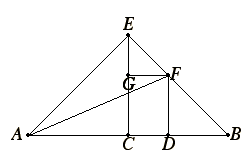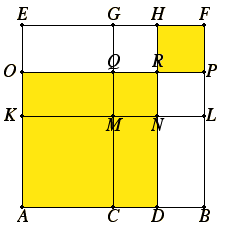Proposition 9
Let a straight line AB be cut into equal segments at C, and into unequal segments at D.
I say that the sum of the squares on AD and DB is double the sum of the squares on AC and CD.

Draw CE from C at right angles to AB, and make it equal to either AC or CB. Join EA and EB. Draw DF through D parallel to EC and FG through F parallel to AB. Join AF.
Then, since AC equals CE, the angle EAC also equals the angle AEC.
And, since the angle at C is right, the sum of the remaining angles EAC and AEC equals one right angle.
And they are equal, therefore each of the angles CEA and CAE is half of a right angle.
For the same reason each of the angles CEB and EBC is also half of a right angle, therefore the whole angle AEB is right.
And, since the angle GEF is half of a right angle, and the angle EGF is right, for it equals the interior and opposite angle ECB, the remaining angle EFG is half of a right angle. Therefore the angle GEF equals the angle EFG, so that the side EG also equals GF.
Again, since the angle at B is half of a right angle, and the angle FDB is right, for it is again equal to the interior and opposite angle ECB, the remaining angle BFD is half of a right angle. Therefore the angle at B equals the angle DFB, so that the side FD also equals the side DB.
Now, since AC equals CE, the square on AC also equals the square on CE, therefore the sum of the squares on AC and CE is double the square on AC.
But the square on EA equals the sum of the squares on AC and CE, for the angle ACE is right, therefore the square on EA is double the square on AC.
Again, since EG equals GF, the square on EG also equals the square on GF. Therefore the sum of the squares on EG and GF is double the square on GF.
But the square on EF equals the sum of the squares on EG and GF, therefore the square on EF is double the square on GF.
But GF equals CD, therefore the square on EF is double the square on CD.
But the square on EA is also double of the square on AC, therefore the sum of the squares on AE and EF is double the sum of the squares on AC and CD.
And the square on AF equals sum of the squares on AE and EF, for the angle AEF is right. Therefore the square on AF is double the sum of the squares on AC and CD.
But the sum of the squares on AD and DF equals the square on AF, for the angle at D is right, therefore the sum of the squares on AD and DF is double the sum the squares on AC and CD.
And DF equals DB.
Therefore the sum of the squares on AD and DB is double the sum of the squares on AC and CD.
Therefore if a straight line is cut into equal and unequal segments, then the sum of the squares on the unequal segments of the whole is double the sum of the square on the half and the square on the straight line between the points of section.
